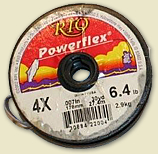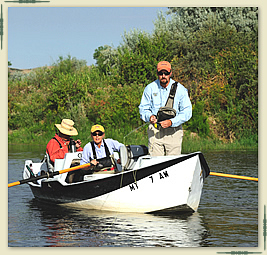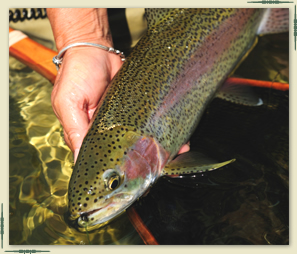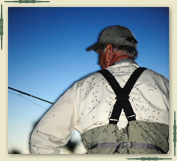Fishing
- Current flow: 6000 cfs
- Matt's Fishing Reports
- Montana fishing licenses online

The Bighorn's cold, clean water helps grow fish so swiftly they often resemble small footballs when they're only a year old. The rich biomass supported by the constant optimum-temperature water released from the bottom of the reservoir feeds fish all year long.
Our typical fish-count is something like 8,000 fish per mile, so there are plenty to go around. Join us to chase a few - or a bunch - and you'll understand why our fishery is justly famous.
The spring-creek style of fishing - slicks, gentle drops at corners, and clear, deep pools - makes fishing the Bighorn a real treat and a challenge.
Because fishing is why we're here and why you're coming, we've split our discussion into three topics so you can get the whole rundown in small gulps, like a trout sipping spinners:
Species
The Bighorn is famous for its big Browns and Rainbows. The Browns are scattered throughout the river's length and width, often clustered in pods lined up along the banks, at the end of riffles, or in 'soft' water with little flow. Check out a riffle during a hatch and you'll find Browns peppering the broken water, just below the surface, waiting for your fly in the rich chowline they're monitoring. Typical size: 12" to 20", with some big ones hidden in deeper waters.
Rainbows, on the other hand, can be very large - up to 27". They hide in the faster, broken water or on the sides of it in the 'gutter' of quiet water bracketing the flow. In the spring and fall, streamers get these guys going, but watch out for their spawning redds during May and June; nobody likes to be disturbed while making love. When you're casting to a pod of risers, look closely for the bigger noses among the mob - these are likely to be Rainbows infiltrating the Browns for a little shared insect intake. Back


Floatfishing
Unlike many other larger rivers in Montana, the Bighorn is best fished on foot, so we use driftboats like water taxis to get you to the best holding water quickly, quietly, and comfortably. However, along the way, feel free to cast to chosen spots with a nymph or to risers with a select dryfly - you'd be surprised at the results.
If you're less mobile, floatfishing is the way to go! Our guides can adjust their choice of stretch so you're just a likely to catch fish as the folks wading . . . maybe even more if you cast like you mean it. Back

Walk-wading
Stalking a gang of fish (or that special single) while spinners or tiny dries disappear in sips or gulps - this is Bighorn fishing! Whether it's the spring trico or PMD hatch, August's black caddis, or fall baetis, our trout respond like none other, so we've got to be ready. Wade slowly, sneak up on them or alongside 'em, loop out some line, then hold on, partner - this is about to get exciting. Your guide will set you up right, adjusting your casting distance to your casting ability, suggesting just the right fly, then quietly coaching as you pick the first victim. Bring good wading shoes, adequate waders, and a wading staff if you want, 'cause the fish are ready. Back
Montana Fishing Licenses
Get your Montana fising license online or from a local shop when you arrive in Ft. Smith. Top

Kingfisher Lodge · PO Box 7828 · Ft. Smith MT 59035
800.835.2529 · 406.666.2326 · 406.666.2356 FAX · bighornkingfisher.com
Design by web-wrx

